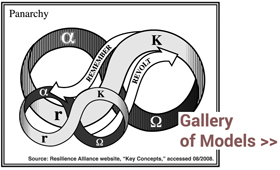What is the role of science in society? It’s a critical question, involving: understandings of expertise, perceptions of credibility and legitimacy, methods for engaging with fact/value entanglements, and so on.
One approach seeks to get at the role of science by examining the ways in which scientific concepts, or models, are used.
Here are two takes, for comparison.
In the 2010 paper, “Resilience and Higher Order Thinking,” Ioan Fazey lists “Possible uses of Resilience Thinking as a framework of inter-related concepts”:
- Prediction — To help make decisions about the likely outcome of a course of action (e.g. using concepts of adaptive cycles to help understand when to target interventions to transform the trajectory of a social-ecological system).
- Explanation — To help suggest why something occurs (e.g. understanding regime shifts or crossing thresholds).
- Identify key questions — For research and/or practice.
- Facilitate design — To help form a plan or scheme to reduce vulnerability of a system to externally induced change.
- Communicate — To convey knowledge and ideas between researchers and/or practitioners.
- Motivate/Engage — To increase broad interest in social and ecological issues.
- Guide practice — To help develop new policies.
- Conceptual change — To help facilitate the way people view social-ecological systems (e.g. through the lens of resilience that sees social-ecological systems as dynamically complex and where, in addition to efficiency, innovation and flexibility are important).
- Development of higher order thinking — Subject of focus for teaching that facilitates development of more sophisticated cognition.
And in the 1973 book Visualizing Change: Model Building and the Change Process, psychologist Gordon Lippitt presented a similar list, in the context of models more broadly (slightly edited for brevity):
- Representation — A model can be used to represent a complex situation and to provide means of making changes in it. It may also help to uncover new relationships between variables.
- Guidance — The model inherently provides rules or guidelines for dealing with situational variables. It can illustrate manipulative constraints and the interdependence of the variables.
- Interpretation — A model can assist in interpreting and testing theory and in establishing a framework for experimentation and discussion.
- Visualization — A model can be used to visualize a change process or an activity, either as an aid to the researcher or change agent, or as a teaching tool.
- Prediction — In certain cases where experimentation is impossible, or impractical, a model can help in predicting the outcome of given events or changes. Its value in this function will be determined by the extent to which the interrelationships are accurately delineated and understood.
- Recreation — Model building can be fun to formulate and can serve as relaxation for the change practitioner. Some of us refer to it as “professional doodling,” but it can be both meaningful and enjoyable.
- Communication — Perhaps the reason communication is not usually included as an important function is because it is considered to be implied in a model. But communication by implication instead of communication by design may be a reason why so many models are not efficacious. A model should execute only “one-way” communication. There are three requisite components for this type of message sending: the source (model builder), the channel (the model) and the receiver (the one directly or indirectly using the model).
See also: “Hamlet and the greenhouse effect as models.”


Howard – thanks for spotting the synergies here. One thing I have learnt is that if I have an idea, its likely to have come before. But I do believe that ideas grow and become more mainstream. Maybe my thoughts on the importance of concepts and models as being important for helping people articulate, reflect on and then improve their own conceptualisations and understanding of the world will also take root…
On another note, I must also acknowledge the input of Barry Newell at the Australian National University for some of these ideas. His work on understanding learning and interdisciplinary have been influential.
Thanks Ioan!